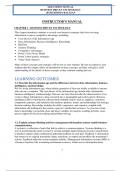SOLUTIONS MANUAL
BUSINESS DRIVEN TECHNOLOGY
10TH EDITION BALTZAN
INSTRUCTOR’S MANUAL
CHAPTER 1 : BUSINESS DRIVEN TECHNOLOGY
This chapter introduces students to several core business strategies that focus on using
information to gain a competitive advantage, including:
Core Drivers of the Information Age
Data, Information, Business Intelligence, Knowledge
Big Data
Systems Thinking
Competitive Advantages
Porter’s Five Forces Model
Porter’s three generic strategies
Value Chain Analysis
Many of these concepts and strategies will be new to your students. Be sure to explain to your
students that this chapter offers an introduction to these concepts, and they will gain a solid
understanding of the details of these concepts as they continue reading the text.
LEARNING OUTCOMES
1.1: Describe the information age and the differences between data, information, business
intelligence, and knowledge.
We live in the information age, when infinite quantities of facts are widely available to anyone
who can use a computer. The core drivers of the information age include data, information,
business intelligence, and knowledge. Data are raw facts that describe the characteristics of an
event or object. Information is data converted into a meaningful and useful context. Business
intelligence (BI) is information collected from multiple sources such as suppliers, customers,
competitors, partners, and industries that analyzes patterns, trends, and relationships for strategic
decision-making. Knowledge includes the skills, experience, and expertise, coupled with
information and intelligence that creates a person’s intellectual resources. As you move from
data to knowledge you include more and more variables for analysis resulting in better, more
precise support for decision-making and problem-solving.
1.2: Explain systems thinking and how management information systems enable business
communications.
A system is a collection of parts that link to achieve a common purpose. Systems thinking is a
way of monitoring the entire system by viewing multiple inputs being processed or transformed
to produce outputs while continuously gathering feedback on each part. Feedback is information
that returns to its original transmitter (input, transform, or output) and modifies the transmitter’s
actions. Feedback helps the system maintain stability. Management information systems (MIS) is
a business function, like accounting and human resources, which moves information about
4
,people, products, and processes across the company to facilitate decision-making and problem-
solving.
MIS incorporates systems thinking to help companies operate cross-functionally. For example, to
fulfill product orders, an MIS for sales moves a single customer order across all functional areas
including sales, order fulfillment, shipping, billing, and finally customer service. Although
different functional areas handle different parts of the sale, thanks to MIS, to the customer the
sale is one continuous process.
CORE MATERIAL
The core chapter material is covered in detail in the PowerPoint slides. Each slide contains
detailed teaching notes including exercises, class activities, questions, and examples. Please
review the PowerPoint slides for detailed notes on how to teach and enhance the core chapter
material. You will find numerous classroom ideas to keep your course exciting and challenge
your students to apply the material.
RUNNING CASE STUDY QUESTIONS
1. You have landed your dream job working for Steve Evert. Unfortunately, Steve does
not understand the difference between data, information, business intelligence, and
knowledge. Choose a product or service and provide examples of data, information,
business intelligence, and knowledge to help Steve understand these important
concepts.
Student data will include gender, weight, height, major, and age. Turning that data into
information can provide insights into the entire group of students. Such things as top majors,
average GPA, graduation rates, grades across class, grades by different teachers, and male to
female ratio. Business intelligence would include outside information such as internship
types, average starting salary, and graduate school choices, course grades across different
schools, economy, and enrollment. Knowledge would include knowing that a professor is
new and expecting course evaluations to be lower than average or that seniors wait until their
last quarter to take the course because it is difficult or that 8 a.m. classes typically receive
higher grades than 4 p.m. classes.
2. Steve does not understand why different departments across the company need to share
data. Explain to Steve why it is important to share data across the accounting,
marketing, sales, and operations management departments.
Businesses operate cross-functionally. Accounting must have data from every department to
function and marketing needs to know what operations is doing to create great marketing
campaigns. For example, if operations create a new generic product such as milk, then
marketing will want to advertise the benefits of purchasing the product directly from the store
to increase sales. If one store is selling more of a particular item, they would want to
understand the different market segments for each store to ensure they have the right
marketing campaigns for each area. A store would not want to sell ice cream in Alaska and
hot chocolate in Hawaii.
5
,3. Steve does not understand systems thinking or how the MIS department enables
business success. Explain systems thinking and how MIS solves the issue with
information silos.
Systems thinking is a way of monitoring the entire system by viewing multiple inputs being
processed or transformed to produce outputs while continuously gathering feedback on each
part. Feedback is information that returns to its original transmitter (input, transform, or
output) and modifies the transmitter’s actions. Feedback helps the system maintain stability.
For example, a store continuously monitors the expiration dates on its frozen and fresh foods
and a warning light will go on if all of the milk is about to expire notifying marketing to
create a campaign to help reduce the price of milk to ensure it all sells before it expires.
Systems thinking provides an end-to-end view of how operations work together to create a
product or service. Business students who understand systems thinking are valuable
resources because they can implement solutions that consider the entire process, not just a
single component.
CHAPTER ONE CASE
1. Why do you believe data can be inaccurate?
There are numerous reasons why data is inaccurate. In fact, it is estimated that over 80% of
spreadsheets have errors. Error upon entering data is a key issue and here are a few problems:
Errors in Inputting Data: Amongst the most typical data entry problems is inputting
the incorrect data. An unintentional mistype can lead to short- or even long-term
troubles. It may also result in incorrect records, wrong information, and
disorganization. It is specifically prevalent in cases of human data entry processes.
Sadly, even the top-notch data entry specialists tend to make mistakes that can cost
heavily to a business. Addition or subtraction of a number or putting in the decimal
point at a wrong place is a small error that may cost your company a great deal of
money.
Incorrect Data Formatting: Even the most advanced data entry software
applications can create issues for a business. Inaccurate formatting is a typical
concern, which can lead to correct data getting inputted in the wrong columns. Just
imagine the date 2/5/2025. Depending on the country you are in, that could be
February 2 or January 5.
Human Errors: Like data inputting concerns that are elaborated above, there exist a
lot of issues that revolve around basic human errors. Issues concerning your
employees like tiredness, the pace at which data is entered, emotional aspects, time
management, and diversions can adversely impact the way in which the data is being
entered. Likewise, people can misjudge data as they may preview one aspect of
information in the wrong way as their brain interprets it.
Misspelling of Names or Other Important Information: “Cheryl Steffan” instead
of “Cheryl Steffen.”
Wrong Date Format While Entering Data in Excel.
Data Misinterpretation: Replacing the letter “O” with the number zero.
Missing Values.
Entering Data in the Wrong Field.
6
, 2. What can a business do to ensure data is correct? What can be done to reduce these
errors?
Stringent quality checks—Double-checking the data entered helps in reducing
errors and eliminates the need for reentering the data. Regular checks will also help
identify areas of improvement.
Train employees—Make sure to train them on the importance of the data they are
handling and let them know the consequences of compromising any data. Ask them to
focus more on accuracy than on speed.
Provide enough time and allow breaks—Even if your operators have good data
entry skills and expertise, there are always chances of mistakes when they are loaded
with a bunch of tasks. Provide a comfortable working environment and offer them
regular breaks to refresh and reset before they return to work.
Update automated systems—If your firm relies on automated tools such as
Intelligent Character Recognition (ICR) and Optical Character Recognition (OCR)
technology for data collection or analysis, make sure to update those systems
regularly. Also, protect automated systems against viruses and malware or it may
result in errors.
Find the source of data inaccuracy—Check the data entry errors that occurred,
statistics, and patterns to determine the primary internal and external sources of data
inaccuracy. This helps to make necessary changes to the processes as well as
management techniques.
Consider outsourcing—Outsourcing data entry and management tasks to an
experienced data entry company will help businesses get the accurate data they are
looking for, along with reduced operational costs, effective data management, and
secured processing.
3. Explain how bad data will impact information, business intelligence, and knowledge.
If you are making decisions on bad data changes are good that you will make a bad decision.
Garbage In is Garbage Out is a classic statement in the MIS field. If the data being entered is
incorrect, then it will be incorrect as it is turned into information, business intelligence, and
knowledge. Managers are only as good as the data they must make decisions. Wrong data,
wrong decision.
4. Have you ever made a decision on bad data? If so, be sure to share it with your peers
and explain how you could have verified the data quality.
This is a great group activity as many students have personal examples. These examples will
help students immediately see the value in this course as they learn how to navigate the data
minefields laid all over organizations today.
5. Argue for or against the following statement: “It is better to make a business decision
with bad data than with no data.”
7





